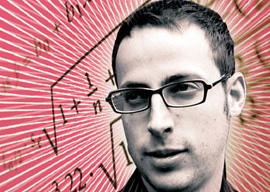
November 28, 2012

Nate Silver
Silver explains that he avoids highly competitive fields such as Wall Street. Instead, he prefers markets, such as poker, baseball, and politics in which he can prey upon the dim or under-motivated. For example:
Billy Beane [the hero of Michael Lewis’s Moneyball] got an awful lot of mileage by recognizing a few simple things, like the fact that on-base percentage is a better measure of a player’s offensive performance than his batting average. Nowadays pretty much everyone realizes that.
Silver has had four different careers in the 2000s”corporate drone, baseball stats whiz, professional poker player, and now the New York Times“ election prognosticator“all useful for a writer of airport books.
Silver started the century as a spreadsheet jockey for the accounting firm KPMG. Bored, he began building a humongous Excel file to predict the careers of baseball prospects. (His bosses naively “assumed I was diligently working on a highly elaborate model for one of our clients.”)
Silver isn”t quite as good a storyteller as Michael Lewis, whose Frequent Flyer Hall of Fame book Moneyball offers the charming story about how Oakland A’s general manager Billy Beane wrestled his underfinanced baseball team into the playoffs by using advanced statistics to find undervalued players. Lewis, however, left out the less-appealing news that Oakland had been Ground Zero of baseball’s steroids epidemic ever since Beane’s mentor Sandy Alderson had brought together Jose Cansecoand Mark McGwire in the 1980s.
Silver whiffed on the biggest baseball-stats story of his era. He didn”t mention steroids online until 2005, when he underestimated their effect. As late as May 2009, Silver wrote in Baseball Prospectus how surprised he was to hear that slugger Manny Ramirez, who had hit .396 after being traded to the Dodgers in 2008, had been caught by a PED test.
Although the word “baseball” appears on 50 pages of The Signal and the Noise, there is, unsurprisingly, no index entry for “steroids.”
There is a lone entry for “stereotype” in which Silver notes:
But poker players don”t have time for political correctness. Even if the stereotype that women play more conservatively than men is false 45 percent of the time, the fact that it might be true 55 percent of the time gives them something to work with.
You might think that a longer discussion of the abuses and uses of stereotypes would be relevant in a book on making predictions. But Frequent Flyer books are extremely politically correct because the end game for the author is less about selling books and more about personal appearances at corporate conferences. And HR departments are leery of letting un-PC experts speak. That’s why someone such as Gladwell makes vastly more money off speeches than does a data maestro such as Charles Murray.
After selling his forecasting system to Baseball Prospectus, Silver became obsessed with poker during that game’s recent fad. The rise and fall of his poker prosperity provides the best chapter in the book, even though Silver misses the obvious-in-hindsight link between the poker bubble and the subprime bubble. In 2003, only 839 people participated in the World Series of Poker in Las Vegas. In 2004, as soaring home prices in what Michael Lewis called the Sand States of Nevada, Arizona, and California turned mortgages into ATMs, there were 2,576 entrants. By 2006, there were 8,773.
Silver made about $400,000 during these years fleecing bad poker players online and at the Bellagio in Las Vegas. Yet from late 2006 to early 2007, Silver lost $135,000 as the “fishes” disappeared from the poker tables, leaving only the poker pros to feast upon each other. A few months into 2007, Silver cashed in and launched a new career as a political expert.
Silver attributes the end of the poker bubble to the Republican Congress regulating online poker. Hilariously, he says this Republican regulation increased his “interest in the political process” and “eventually led to the development of FiveThirtyEight.”
But a more fundamental reason for the poker bust that Silver still doesn”t notice would appear to be that home prices topped out in 2006, followed by the collapse of subprime lenders in the winter of 2007. As net worths sank, giddy Sand Staters stopped heading to Vegas to lose to gimlet-eyed pros such as Silver.
In other words, the poker bust was a leading indicator of the housing bust. The funny thing is that playing poker had given Silver the information he could have used to make the biggest, most profitable forecast of his lifetime: The subprime jig was up. (See Michael Lewis’s Frequent Flyer classic The Big Short for biographies of guys who made billions off accurate forecasts about the housing bubble.) Yet Silver missed it. In fact, he still doesn”t get it.
But don”t feel too sorry for poor Nate Silver. He”ll make plenty of money writing books and, especially, giving speeches. In fact, he”ll deserve the money more than most of his competition.